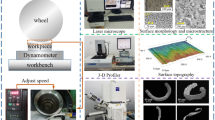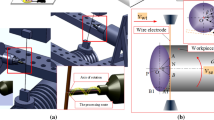Abstract
According to the significant anisotropy of nickel-based single-crystal superalloy, a three-dimensional single-abrasive grinding model based on the Hill model was developed. In work, the change of the actual grinding thickness (ag) of abrasive is taken into account in establishing the model. In addition, a combination of theoretical research and experimental research is used. The surface morphology and chip morphology of DD5 were first studied. Then, the chip morphology evolution and the grinding force change were investigated. Finally, the influence of grinding speed (vs) on chip morphology and chip segmentation frequency (fc) was studied. The research shows that serrated chips can easily occur when machining DD5 within the range of grinding parameters. The grinding force increased steadily and was accompanied by inevitable periodic fluctuations corresponding to serrated chips. As the grinding speed increased, the abrasive could enter the cutting stage more quickly, and their critical chip thickness (acr) eventually decreased from 0.225 to 0.158 μm, and the percentage of the cutting phase increased from 85 to 89.5%. The critical scratch thickness, on the other hand, was not significantly influenced by the change in grinding speed. The grinding speed and thickness substantially influence the morphology and segmentation frequency of DD5 chips. Specifically, when grinding speed continues to increase, the DD5 chip morphology changed from a densely stacked unit nodal shape with serrated subsections to a continuous type of serrated shape and finally developed into a strip-shaped chip. At different grinding speeds, the chip segmentation frequency of DD5 decreases with increasing grinding depth.





















Similar content being viewed by others
Data availability
All data and materials used to produce the results in this article can be obtained upon request from the corresponding authors.
Code availability
Not applicable.
References
Song YH, Li YG, Li HY, Zhao GH, Cai ZH, Sun MX (2022) Hot deformation and recrystallization behavior of a new nickel-base superalloy for ultra-supercritical applications. J Mater Res Technol 19:4308–4324. https://doi.org/10.1016/j.jmrt.2022.06.141
Salur E (2022) Understandings the tribological mechanism of Inconel 718 alloy machined under different cooling/lubrication conditions. Tribol Int 174:107677. https://doi.org/10.1016/j.triboint.2022.107677
Pollock TM (2016) Alloy design for aircraft engines. Nat Mater 15(8):809. https://doi.org/10.1038/nmat4709
Zhang ZB, Yang ZB, Lu S, Harte A, Morana R, Preuss M (2020) Strain localization and failure at twin-boundary complexions in nickel-based superalloys. Nat Commun 11:4890. https://doi.org/10.1038/s41467-020-18641-z
Singh R, Sharma V (2022) Machining induced surface integrity behavior of nickel-based superalloy: effect of lubricating environments. J Mater Process Tech 307:117701. https://doi.org/10.1016/j.jmatprotec.2022.117701
Singh A, Ghosh S, Aravindan S (2022) State of art for sustainable machining of nickel-based alloys using coated and uncoated tools and machining of high strength materials using surface modified cutting tools. Tribol Int 170:107517. https://doi.org/10.1016/j.triboint.2022.107517
Liao ZR, Xu DD, Luna GG, Axinte D, Augustinavicius G, Sarasua JA, Wretland A (2021) Influence of surface integrity induced by multiple machining processes upon the fatigue performance of a nickel based superalloy. J Mater Process Tech 298:117313. https://doi.org/10.1016/j.jmatprotec.2021.117313
Qu SS, Yao P, Gong YD, Chu DK, Yang YY, Li CW, Wang ZL, Zhang XP, Hou Y (2022) Environmentally friendly grinding of C/SiCs using carbon nanofluid minimum quantity lubrication technology. J Clean Prod 36:132898. https://doi.org/10.1016/j.jclepro.2022.132898
Sun YJ, Zhu T, Cai M, Zhang YX, Fan CR, An ZX (2022) Influence of grinding lubrication methods on surface integrity of nickel-based single crystal superalloy. Diamond Abras Eng 42(2):201–207. https://doi.org/10.13394/j.cnki.jgszz.2021.0114
Ding WF, Miao Q, Li BK, Xu JH (2019) Review on grinding technology of nickel-based superalloys used for aero-engine. J Mech Eng 55(1):189–215. https://doi.org/10.3901/JME.2019.01.189
Li BK, Ding WF, Ma YY, Xiao H, Huang QF, Si WY, Yang J (2021) Performance evaluation on grinding of nickel-based superalloy GH4169 using new corundum abrasive wheel. Aeronaut Manuf Technol 64(4):14–19. https://doi.org/10.16080/j.issn1671-833x.2021.04.014
Cai M, Gong YD, Sun Y, Qu SS, Liu Y, Yang YY (2021) Experimental study on grinding surface properties of nickel-based single crystal superalloy DD5. Int J Adv Manuf Technol 64(4):14–19. https://doi.org/10.1007/s00170-018-2839-3
Li BK, Ding WF, Li M, Zhang X (2021) Tool wear behavior of alumina abrasive wheels during grinding FGH96 powder metallurgy nickel-based superalloy. Procedia CIRP 101:182–185. https://doi.org/10.1016/j.procir.2020.04.161
Miao Q, Ding WF, Gu YL, Xu JH (2019) Comparative investigation on wear behavior of brown alumina and microcrystal line alumina abrasive wheels during creep feed grinding of different nickel-based superalloys. Wear 426–427:1624–1634. https://doi.org/10.1016/j.wear.2019.01.080
Zhao ZC, Qian N, Ding WF, Wang Y, Fu YC (2020) Profile grinding of DZ125 nickel-based superalloy: grinding heat, temperature field, and surface quality. J Manuf Process 57:10–22. https://doi.org/10.1016/j.jmapro.2020.06.022
Zhu T, Cai M, Gong YD, Gao XJ, Yu N, Li X (2022) Study on chip formation in grinding of nickel-based polycrystalline superalloy GH4169. Int J Adv Manuf Technol 121:1135–1148. https://doi.org/10.1007/s00170-022-09386-8
Sun Y, Su ZP, Gong YD, Ba D, Yin GQ, Zhang H, Zhou LH (2021) Analytical and experimental study on micro-grinding surface-generated mechanism of DD5 single-crystal superalloy using micro-diamond pencil grinding tool. Arch Civ Mech Eng 21(1):1–22. https://doi.org/10.1007/s43452-020-00163-6
Tian L, Fu YC, Xu JH, Li HY, Ding WF (2015) The influence of speed on material removal mechanism in high speed grinding with single grit. Int J Mach Tool Manu 89:192–201. https://doi.org/10.1016/j.ijmachtools.2014.11.010
Öpöz TT, Chen X (2012) Experimental investigation of material removal mechanism in single grit grinding. Int J Mach Tool Manu 63:32–40. https://doi.org/10.1016/j.ijmachtools.2012.07.010
Zhao JY, Fu YC, Xu JH, Tian L, Lu Y (2013) Forces and chip morphology of nickel-based superalloy inconel 718 during high speed grinding with single grain. Key Eng Mater 589–590:209–214. https://doi.org/10.4028/www.scientific.net/KEM.589-590.209
Yang M, Li CH, Zhang YB, Jia DZ, Li R, Hou YL, Cao HJ, Wang J (2019) Predictive model for minimum chip thickness and size effect in single diamond grain grinding of zirconia ceramics under different lubricating conditions. Ceram Int 45(12):14908–14920. https://doi.org/10.1016/j.ceramint.2019.04.226
Liang ZQ, Wang XB, Wu YB, Xie LJ, Jiao L, Zhao WX (2013) Experimental study on brittle–ductile transition in elliptical ultrasonic assisted grinding (EUAG) of monocrystal sapphire using single diamond abrasive grain. Int J Mach Tool Manu 71:41–51. https://doi.org/10.1016/j.ijmachtools.2013.04.004
Zhu YD, Zhang QL, Zhao QL, To S (2021) The material removal and the nanometric surface characteristics formation mechanism of TiC/Ni cermet in ultra-precision grinding. Int J Refract Met H 96:105494. https://doi.org/10.1016/j.ijrmhm.2021.105494
Li C, Zhang FH, Wang X, Rao XS (2018) Repeated nanoscratch and double nanoscratch tests of Lu2O3 transparent ceramics: material removal and deformation mechanism, and theoretical model of penetration depth. J Eur Ceram Soc 38(2):705–718. https://doi.org/10.1016/j.jeurceramsoc.2017.09.028
Lortz W, Govekar E (2021) Advanced modelling for grinding - from friction to ploughing and dynamic chip formation with temperatures. Procedia CIRP 102:79–84. https://doi.org/10.1016/j.procir.2021.09.014
Sima M, Özel T (2010) Modified material constitutive models for serrated chip formation simulations and experimental validation in machining of titanium alloy Ti–6Al–4V. Int J Mach Tools Manuf 50:943–960. https://doi.org/10.1016/j.ijmachtools.2010.08.004
Calamaz M, Coupard D, Girot F (2008) A new material model for 2D numerical simulation of serrated chip formation when machining titanium alloy Ti-6Al-4V. Int J Mach Tools Manuf 48:275–288. https://doi.org/10.1016/j.ijmachtools.2007.10.014
Fu DK, Ding WF, Miao Q, Xu JH (2017) Simulation research on the grinding forces and stresses distribution in single-grain surface grinding of Ti-6Al-4V alloy when considering the actual cutting-depth variation. Int J Adv Manuf Technol 91:3591–3602. https://doi.org/10.1007/s00170-017-0084-9
Gong YD, Zhou J, Zhou YG, Huang XJ (2018) Micro-grinding temperature simulation for nickel-based single crystal superalloy. J Northeast Univ 39(1):82–86. https://doi.org/10.12068/j.issn.1005-3026.2018.01.017
Chen ZZ, Tian L, Fu YC, Xu JH, Ding WF, Su HH (2012) (2012) Chip formation of nickel-based superalloy in high speed grinding with single diamond grit. Int J of Abras Technol 5(2):93–106. https://doi.org/10.1504/IJAT.2012.048537
Ding WF, Li Z, Liu CJ, Zhou H (2018) Grinding performance of TiCp/Ti-6Al-4V composites with CBN wheels, part II: material removal behavior based on FEM. Procedia CIRP 77:529–532. https://doi.org/10.1016/j.procir.2018.08.242
Liu GL, Huang CZ, Su R, Özel T, Liu Y, Xu LH (2019) 3D FEM simulation of the turning process of stainless steel 17–4PH with differently texturized cutting tools. Int J Mech Sci 155:417–429. https://doi.org/10.1016/j.ijmecsci.2019.03.016
Xu YC, Gong YD, Zhang WJ, Wen XL, Xin B, Zhang H (2022) Effect of grinding conditions on the friction and wear performance of Ni-based singlecrystal superalloy. Arch Civ Mech Eng 22:102. https://doi.org/10.1007/s43452-022-00423-7
Dai CW, Ding WF, Xu JH, Fu YC, Yu TY (2017) Influence of grain wear on material removal behavior during grinding nickel-based superalloy with a single diamond grain. Int J Mach Tool Manu 113:49–58. https://doi.org/10.1016/j.ijmachtools.2016.12.001
Ding ZP, Liu YL, Yin ZY, Yang ZG, Cheng XM (2004) Study of yield criterion for single crystal nickel-based superalloys. J Mech Strength 26(2):175–179. https://doi.org/10.16579/j.issn.1001.9669.2004.02.011
Ding ZP, Liu YL, Yin ZY, Yang ZG, Cheng XM. (2004) Constitutive model for FCC single crystal material. J Cent South Univ (3):423-428. 1672-7207(2004) 03-0423-06
Feng L, Zhang KS, Zhang G. (2003) Comparative study of Hill model with crystal plasticity for FCC single crystals. J Comput Mech 20(5): 535-540+573. 1007-4708(2003) 05-0535-06
Qing JC, Cui RJ, Huang CH (2020) Effect of low angle grain boundaries on mechanical properties of DD5 single crystal Ni-base superalloy at medium temperature and high temperature. J Mater Eng 48(10):114–122. https://doi.org/10.11868/j.issn.1005-5053.2016.000127
Yang Y, Cheng XL (2002) (2002) Current status and trends in researches on adiabatic shearing. Chin J Nonferrous Met 3:401–408. https://doi.org/10.19476/j.ysxb.1004.0609.2002.03.001
Xu YC, Gong YD, Wang ZX, Wen XL, Yin GQ, Zhang H, Qi Y (2021) Experimental study of Ni-based single-crystal superalloy: microstructure evolution and work hardening of ground subsurface. Arch Civ Mech Eng 21:43. https://doi.org/10.1007/s43452-021-00203-9
Tian L, Fu YC, Yang L, Xu JH, Li HY, Ding WF (2013) Investigations of the “speed effect” on critical thickness of chip formation and grinding force in high speed and ultra-high speed grinding of superalloy. J Mech Eng-En 49(9):169–177. https://doi.org/10.3901/JME.2013.09.169
Xia J, Ding WF, Qiu B, Xu JH (2020) 3D simulation study on the chip formation process in high speed and ultra-high speed grinding of nickel-based superalloy. Diamond Abras Eng 40(6):58–69. https://doi.org/10.13394/j.cnki.jgszz.2020.6.0011
Funding
This work was supported by the National Natural Science Foundation of China (nos. U1908230 and 51775100), the Science and Technology Research Project of the Educational Department of Liaoning Province (nos. LJKZ0384 and L2017LQN024), and the Talent Scientific Research Fund of LNPU (no. 2021XJJL-007).
Author information
Authors and Affiliations
Contributions
Tao Zhu: writing—original draft, conceptualization, and visualization. Ming Cai: writing—original draft, software, investigation, visualization, and funding. Yadong Gong: supervision, investigation, and methodology. Xingjun Gao: conceptualization, methodology, and formal analysis. Ning Yu: data curation and formal analysis. Qiang Gong: data curation and formal analysis.
Corresponding author
Ethics declarations
Ethics approval
The authors declare that there is no ethical issue applied to this article.
Consent to participate
The authors declare that all authors have read and approved to submit this manuscript to IJAMT.
Consent for publication
The authors declare that all authors agree to sign the transfer of copyright for the publisher to publish this article upon on acceptance.
Competing interests
The authors declare no competing interests.
Additional information
Publisher's note
Springer Nature remains neutral with regard to jurisdictional claims in published maps and institutional affiliations.
Rights and permissions
Springer Nature or its licensor (e.g. a society or other partner) holds exclusive rights to this article under a publishing agreement with the author(s) or other rightsholder(s); author self-archiving of the accepted manuscript version of this article is solely governed by the terms of such publishing agreement and applicable law.
About this article
Cite this article
Zhu, T., Cai, M., Gong, Y. et al. Study on the chip formation in grinding of nickel-based single-crystal superalloy DD5. Int J Adv Manuf Technol 125, 5781–5798 (2023). https://doi.org/10.1007/s00170-023-11096-8
Received:
Accepted:
Published:
Issue Date:
DOI: https://doi.org/10.1007/s00170-023-11096-8




